Abstract
Forecasting the compressive strength of concrete is a complex task owing to the interactions among concrete ingredients. In addition, an important characteristic of the concrete failure surface is its six-fold symmetry. In this study, an artificial neural network (ANN) and adaptive neuro fuzzy interface system (ANFIS) were employed to model the compressive strength of natural volcanic ash mortar (VAM) by using the six-fold symmetry of concrete failure. The modeling was correlated with four parameters. To train and test the projected models, data for more than 150 samples were collected from the literature. Furthermore, mortar samples with varying proportions of volcanic ash were prepared in the laboratory and tested, and the results were used to validate the models. The performance of the developed models was assessed using numerous statistical measures. The results show that both the ANN and ANFIS models accurately predict the compressive strength of VAM with R-square above 0.9 and lower error statistics. The permutation feature analysis confirmed that the age of specimens affects the strength of VAM the most, followed by the water-to-cement ratio, curing temperature, and percentage of volcanic ash.
1. Introduction
Construction industries are known for their hazardous effects on the environment [1,2]. Recent studies have shown that construction industries consume 40% of the world’s energy [3,4]. Furthermore, they are responsible for 23% of air pollution, 45% of landfill waste, and 35% of CO2 emissions [5,6]. Hence, efforts are being made worldwide to reduce the high carbon footprint of construction industries [7,8]. Concrete is an essential man-made material in the industry and the second-most utilized material in the world [9,10]. Cement, the binding material in concrete, causes 7% of the total CO2 emissions and consumes around 15% of the total energy used by industries [11,12,13]. However, the demand for cement is at its peak and is estimated to reach 6000 million tons in the next four decades. To reduce the high carbon footprint and CO2 emissions of construction industries, there is a need to reduce cement usage. The demand for cement can only be reduced if construction industries adopt alternative environmentally friendly binding materials [14,15].
Locally available natural materials have been successfully used as supplementary cementitious materials (SCMs) in several studies [16,17,18,19,20,21,22]. The main advantage of SCMs is that they reduce cement usage by as much as 30% [2,23]. Recent studies showed that replacing cement with SCMs enhances economical and sustainable construction [24,25,26]. CO2 emissions per unit compressive strength of concrete are reduced when 20% cement is replaced with SCMs [27,28]. Besides the environmental benefits, replacing with SCMs increases the mechanical strength of concrete due to their pozzolanic nature [29,30,31]. In addition, it enhances the durability of concrete due to the improved pore structure [26,27,32,33,34]. Hence, replacing cement with SCMs is a good choice to reduce the use of cement and enhance concrete strength and durability. However, using imported SCMs for concrete production in the Gulf area increases the overall cost of projects, which in turn affects the sustainability of the project [35,36]. Hence, in the last decade, engineers have focused on the potential and exploration of locally available SCMs, such as volcanic ash (VA), for use in construction projects. Recently, large reservoirs of volcanic pozzolan (containing natural basaltic VA) were found in several parts of western KSA [37,38]. These volcanic pozzolans can be used as SCMs in concrete without affecting the overall cost of the project as they are cheaper than imported SCMs.
Earlier research findings focused on the hydration of mortar and concrete in which cement is partially replaced with VA [39,40,41]. In addition, several experimental research studies have been performed on the effect of partial replacement of cement with VA on the strength of concrete [38,42]. However, to date, no model has been developed to accurately predict the compressive strength of concrete in which cement is partially replaced by VA. This is attributed to the complexity and composition of VA, as VA is a natural pozzolana and is found in various parts of the globe. The properties of VA vary with the origin, particle characteristics, mode of formation, and mineralogical composition [43,44]. The lack of accurate models for estimating the properties of VAM limits the practical use of VA. However, experimental evaluation of different mechanical and physical properties of VAM is tiresome, time-consuming, labor-intensive, and expensive. Moreover, the mechanical properties of mortars are affected by numerous factors including the skill of labor and accuracy of machines; thus, laboratory data are unreliable. In addition, an important characteristic of the concrete failure surface is its six-fold symmetry. This property can be applied in two steps. First by minimizing the number of experimental tests to one of the symmetric parts only and then evaluating the peers of each point to obtain the full surface. The second application of this property is to average the symmetric parts after fitting to lower the error and obtain a final surface consistent with the theoretical assumptions. Previously, solving the symmetry was time-consuming and required high-level mathematical skills; however, symmetrical problems can be solved easily with the help of artificial intelligence [45]. These reasons have increased the use of machine learning techniques in estimating the mechanical properties of mortars in recent years [46,47,48,49]. Different types of machine learning techniques have been successfully employed in different types of concrete and mortar [50,51,52,53]. Meanwhile, the application of machine learning in civil engineering is not restricted to the prediction of mechanical properties of mortar and concrete. Machine learning has been employed by practicing engineers and professionals to predict various important parameters [54,55,56,57,58]. Among different machine learning techniques, neural networks like ANN and ANFIS have gained more popularity due to their ability to predict responses in complex systems [59,60,61]. Both mentioned techniques are discussed in detail in a later section.
There is an indispensable requirement to develop accurate and fast methods for predicting the compressive strength of VAM and increase the use of such mortars. In this study, we investigated the effect of partially replacing cement in mortar with VA at different percentages as well as the effect of different curing temperatures at different ages of mortar. Several experimental tests were performed on mortar specimens to determine their maximum compressive strengths. Furthermore, we developed a computational model using a machine learning technique to accurately forecast the compressive strength of VAM. The results of this study will be vital in the development of green concrete to reduce global CO2 emissions.
2. Materials and Methods
2.1. Experimental
Ordinary Portland cement (OPC), also known as Type-I cement, produced in a Saudi cement factory, was utilized to prepare mortar samples. Locally available VA, provided by the Super Burkani Blocks Company located in Jeddah, Saudi Arabia, was used. It was supplied in the form of a fine powder, with an average particle size of 30 µm. To obtain relatively very fine particles of VA, dry sieving was performed on the supplied VA with micro-sieves #400 and #635 to extract from it the fine VA (VF) and ultra-fine VA (VUF), respectively. The results of the physical and chemical analyses of the OPC and VA used in the current research are listed in Table 1.

Table 1.
Physical and chemical characteristics of OPC and VA.
The particle size analysis curves of the cement and VA are shown in Figure 1. Commercially available standard sand with a fineness modulus of 2.54 was used to prepare the mortar samples. Details of the sieve analysis of the sand are shown in Table 2.
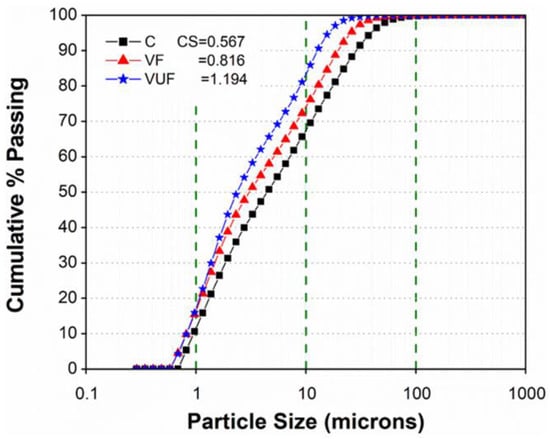
Figure 1.
Particle size distribution curves of cement, fine volcanic ash (VF), and ultra-fine volcanic ash (VUF).

Table 2.
Grain size distribution of fine aggregate (EN 196-1 and ISO 679:2009).
Including the control mix (CM), a sum of four mixes were prepared by replacing cement with different percentages of VA (10%, 20%, and 30%). A consistent water-to-cement ratio (w/c) of 0.487 was exercised for all the mixes according to ASTM C192 [63]. The specific details of all prepared mixes are listed in Table 3.

Table 3.
Quantities of mixture proportion variables of mortar (w/c = 0.485; C: S = 1: 2.75).
For all mixes, identical cubic specimens of size 50 mm were cast. After 24 h of casting, the specimens were demolded and moist-cured at different temperatures (20 °C, 40 °C, and 60 °C) until the testing age. The compressive strengths of the mortar specimens were evaluated at three ages (7, 28, and 91 days) according to ASTM C192. A universal compressive testing machine with a capacity of 300 kN and a loading rate of 1 mm/min was used to evaluate the compressive strength of the specimens. Three samples were tested for each age and the mean values were calculated. Further details of the experimental procedures are available in the literature [64].
2.2. Modeling
Recently, the use of ANN and ANFIS in predicting different engineering properties of concrete has improved exponentially in every field due to their numerous advantages [65,66]. Among all artificial intelligence techniques, many researchers in the field of civil engineering prefer ANN and ANFIS due to their outburst predictive capacity [67,68,69]. Models that can predict different properties of concrete based on experimental data can be developed using ANN and ANFIS. The detailed methodology adopted in this study for establishment of these models is presented herein.
2.2.1. Artificial Neural Network
ANNs exhibit high performance, require no detailed knowledge about the underlying mechanisms, and are more economical than other artificial intelligence methods. Previous studies employed various types of ANNs, including the spiking neural network, radial basis function network, Kohonen network, and Hopfield network. Each type of ANN has its own advantages and disadvantages for different types of data sets. The feed-forward neural network (FFNN) is widely used in predicting the compressive strength of concrete due to its simplicity and robustness.
FFNNs use unidirectional connections to create relationships between input parameters and target value [70,71]. The neurons present in various layers are also connected by unidirectional setups. Two types of FFNNs can be used to create predictive models. Single later perceptron is used for linear problems due to its simplicity, and multilayer perceptron is used for nonlinear complex problems due to its ability to efficiently solve complex problems. Here, we employed the multilayer perceptron. Multilayer perceptron consists of inputs, outputs, weights, neurons, mathematical functions, and hidden layers. Inputs are received from the user and transferred to the hidden layers. No computation is performed while transferring data from input to the hidden layers. All processing is performed in hidden layers using mathematical functions and neurons. After processing, the output is presented to the user for further analyses (if required). The whole process is summarized in Figure 2 for a couple of inputs and outputs, three multilayer perceptrons, and three neurons.
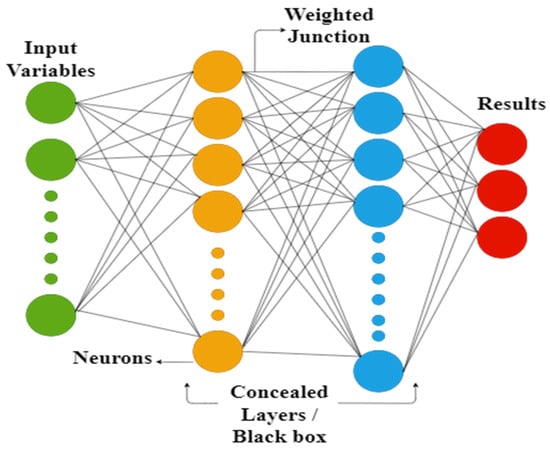
Figure 2.
Simple artificial-neural-network showing multilayer perceptron.
Figure 3 shows how neurons function in FFNNs. Weighted bias and inputs are received, upon which mathematical functions are applied and the values are presented as an output. Mathematically, the multilayer perceptron calculates the output through the following steps.
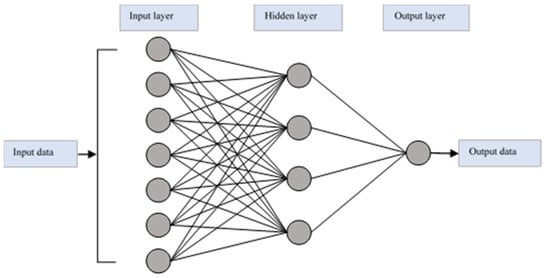
Figure 3.
Single neuron in multilayer perceptron.
- The summations of weighted inputs are calculated using weights and bias.
- The output of the neurons is calculated using different mathematical functions, such as sigmoid and ramp. Here, the sigmoid function is employed due to its simplicity.
- The final output is calculated using the following equations:where is the weight from the node to the target node and is the bias of the target node.
Learning of ANNs starts after the finalization of biases and weights. Among all parameters, only the biases and weights affect the output values. Back-propagation is employed here to train the ANNs using multilayer perceptron, as recommended in previous studies.
The multi-layered FFNN method combined with back-propagation is used in this study. The nonlinear sigmoid function is used to connect two hidden layers. Four neurons are used as input layers, whereas a single neuron is obtained in the output layer. Two hidden layers are used to minimize the percentage error. Seven neurons are used in both hidden layers. Four parameters (percentage, cement, temperature, and day) are employed as inputs and the compressive strength is the output. Details of hyper-parameters utilized while performing an ANN modeling are provided in Table 4.

Table 4.
Values of different hyper-parameters in the neural network model.
2.2.2. Adaptive Neuro-Fuzzy Interface System
Zadeh introduced the concept of fuzzy logic to represent complex systems [72]; it has gained popularity and also been effectively applied to a variety of civil engineering issues, particularly for forecasting mechanical properties of concrete composites made of waste ashes, like fly-ash, bagasse ash, and rice-husk-ash. Fuzzy logic has recently been strongly suggested for simulating properties of different types of concrete in order to address the intrinsic inaccuracy and ambiguous features [3]. The fundamental issue with fuzzy logic algorithms, however, is the unavailability of a consistent process for designing a fuzzy controlling algorithm. An ANFIS, on the other side, has the potential to understand from its surroundings (input to output combinations), modifying its architecture in a self-organized way, and adjusting it in an accessible condition. As a result, we suggest using the ANFIS technique to inherently re-organize neural network structure architecture and modify fuzzy system performance parameters for forecasting the compressive strength of VAM.
Unlike ANN, the ANFIS architecture combines ANN learning techniques and a fuzzy logical reasoning algorithm for a map showing an input space (representing an independent variable) to an output space (representing a dependent parameter). ANFIS has recently been used as an influential and powerful modeling technique for the estimation of numerous properties of concrete [3,73], due to its capacity to integrate the verbal and linguistic power of a fuzzy logic system with the numerical power (floating point data analysis) of a neural system. ANFIS is capable of learning, building, and categorizing. It has the benefit of extracting fuzzy logic rules from numerical information or professional expert information and constructing a rule framework flexibly. It can also fine-tune the complex transfer of human intellect to fuzzy networks. The major disadvantage of the ANFIS estimation method is the time required for structured methodology and hyper-parameter determination, which can take a long time. For the sake of clarity and simplicity, we can suppose that the fuzzy system in discussion contains two input variables (x1 and x2) and one outcome (z). A standard set of rules contains two IF–THEN rules for the interpretation of a first-order Takagi–Sugeno fuzzy model [74]. Equations (3) and (4) represent the two IF-THEN rules stated below.
The , , and (‘i’ is 1 or 2) dictate the linear or consequent parameters of the IF-THEN statements, also known as the consequent part. A concise explanation of the five layers as shown in Figure 4 is given below.
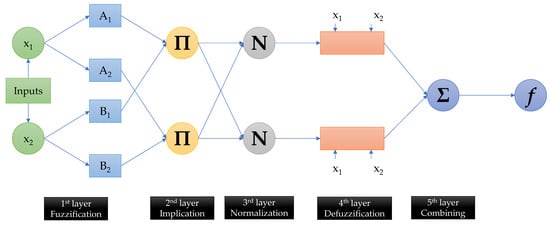
Figure 4.
The basic architectural flow chart of an adaptive-neuro-interface-system algorithm for two variables.
- First Layer (input nodes and fuzzification): This layer takes the inputs and recognizes the linked membership functions. Applying membership function parameters, all nodes in this layer produce membership scores indicating whether or not they correspond to each of the relevant fuzzy sets.
- Second Layer (rule nodes): In the rule layer, the firing strengths for the designated rules are generated. The AND operator is used to produce a single outcome that reflects the consequence of the predecessor (i.e., firing strength). Firing intensity refers to the degree to which the predecessor portion of a fuzzy set rule is fulfilled. It shapes and influence the rule’s output function.
- Third Layer (average nodes or normalization): In this layer the normalized firing capacity is computed. The primary goal of this layer is achieved by calculating the ratio between all firing strengths of the rule to the addition of the firing strength of the entire rules.
- Fourth Layer (consequent parametric node): This layer receives the normalized firing capacity and determines the influence of every set rule to the complete outcome and function using the consequent parametric set.
- Fifth Layer (output nodes or defuzzification): This layer provides the final resultant outcome by adding all the receiving signals. Consequently, at this layer, the defuzzification process converts the fuzzy outcomes of each rule into a clear and definable output.
Like ANN, ANFIS was also executed in MATLAB. The same four inputs (percentage, cement, temperature, and day) and single outputs (compressive strength) were employed. After uploading the data arrays, the number of hyper-parameters provided in Table 5 were selected next to several initial trials. The Takagi–Sugeno fuzzy interface structure with triangular membership (trimf) in combination with a hybrid optimization procedure (back-propagation and least-squares) gives the best performing model [74]. The ANFIS provides the leading performance in comparison with ANN because of its integrated algorithmic architecture of ANN and fuzzy logic rule set.

Table 5.
Values of different parameters in the adaptive neuro-fuzzy interface system model.
2.2.3. Database Development
A comprehensive dataset of VAM properties was adapted from the literature [32,75,76,77,78,79,80,81,82,83] and analyzed to find the parameters affecting the properties of VAM the most. The literature review revealed that the properties of mortar with admixtures and SCMs are affected by the type and dosage of the admixtures [84]. Thus, we chose the proportion of VA (VA%), w/c, curing temperature, and age of the specimens as input parameters. The sand-to-cement ratio for the whole database was kept constant.
2.2.4. Data Representation Using Python
The database representation was performed using Python 3.7. The database consists of four input parameters named VA%, curing temp, age, and binder ratio, whereas compressive strength is the output. All the input parameters selected affect the compressive strength of the mortar directly. The complete dataset was divided into three sets; 70% was utilized to train the model, 15% to test the data, and 15% to validate the model. This distribution can be changed in different studies; however, it is recommended by numerous researchers. The maximum and minimum values for all parameters (input and output) and some statistical indicators are shown in Table 6. The correlation of input variables to the output variable, optimal dosage, and effect of all variables were calculated using built-in libraries of Python 3.7. The details are shown in Figure 5. It is well-known that the variables in a model have a significant impact on its performance. Deep learning is a method used in a neuron-based artificial intelligence approach to estimate material properties depending on the concentration of variables. Python was used to implement a machine learning technique, and the correlation plot was created with the help of the seaborn command. The performance evaluation and accurateness of the model are greatly affected by the selected input variables.

Table 6.
Statistical description of data in the model.
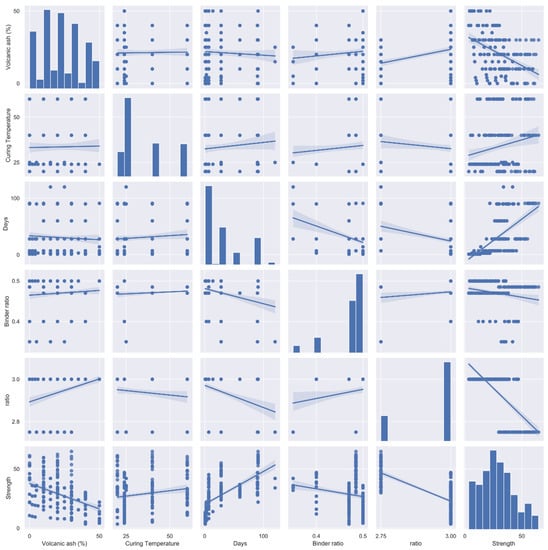
Figure 5.
Relationship between input variables and targeted output strength.
2.2.5. Python-Based Contour Maps
Using Python, five contour maps were drawn and are shown in Figure 6. As discussed in the previous section, the model performance is greatly reliant on the range of input variables. Thus, it is important to determine the optimal quantity of the variables rather than using experimental values. This offers a valuable representation to estimate the strength of VAM.
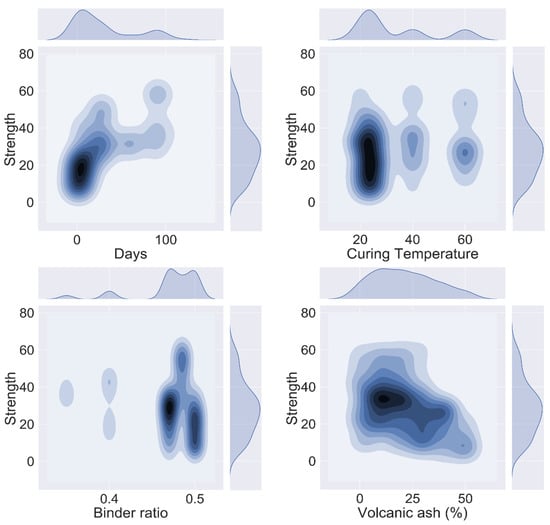
Figure 6.
Python-based contour plots of input variables with the regression graph.
2.2.6. Performance Evaluation of Prediction Models
The accuracy of the developed model was evaluated using six performance indicators, including the mean absolute error (MAE), coefficient of determination (R-square), root-mean-square error (RMSE), root-squared-error (RSE), percentage of relative-root-mean-square-error (RRMSE%), and performance index (). The greater the value of R-square and the lower the stated error statistics, the better the performance of the models will be. The performance index is the ultimate metric for performance evaluation, as it combines the effect of both error statistics and goodness of fit. It is recommended in the literature that the performance index and RRMSE% should be less than 0.2 and 10%, respectively, to classify the model as good [85,86]. The formulas for calculating the mentioned metrics of performance assessment are as follows.
where are the actual measured and model predicted values of compressive strengths, respectively, and and are the mean values of the actual measured and model predicted compressive strengths, respectively.
3. Results and Discussion
3.1. Test Findings
Compressive Strength in Respect of Curing Temperature and Age
As mentioned earlier, the main objective of this research was to explore the effect of VA replacement as cement up to 30% on the compressive strength development of mortar at different curing temperatures and aging. The compressive strengths of the various mortar samples at several aging and curing temperatures are listed in Table 7. In the specimens containing VA, cement was substituted up to 30% with increments of 10%.

Table 7.
Compressive strength (MPa) of mortars at different aging and curing temperatures.
Under standard curing conditions of 20 °C, the compressive strength of the specimens with VA was reduced as compared to CM at all ages, irrespective of the VA%. Moreover, the decrease in compressive strength increased as VA% increased up to 20%. Although the compressive strength decreased at early ages, most possibly because of the lesser or no pozzolanic activity, the mortar with 30% VA exhibited compressive strength comparable to that of CM at later ages (91 days). This could be credited to the delayed pozzolanic reaction of VA. These outcomes show that the partial substitution of cement with VA might not be beneficial, regarding the development of compressive strength. However, unlike standard curing conditions, the compressive strength of VA was significantly enhanced when subjected to moderate or high curing temperatures. This demonstrates an improved reactivity of the mortar with VA under high curing temperatures. For instance, the compressive strength of VAM samples with 10% and 20% VA (VF10 and VF20) was comparable to that of CM at a higher age (i.e., 91 days) and high curing-temperature (i.e., 60 °C). The satisfactory performance of VAM under higher curing temperature is a good indication and thus can be used under hot environmental conditions.
3.2. Modeling Results
3.2.1. ANN Prediction Model
Figure 7 shows the regression analysis plot between the experimental and predicted training, testing, and validation datasets of the ANN predictive model. The linear least-squares fit lines for each data set are also shown in the figure. The error between the experimental and predicted values is very small. R-square for the three datasets is greater than 0.5 and close to 1 i.e., 0.84 and 0.86 each, respectively, showing a close relationship between the predicted and experimental values. Table 8 lists the performance indicators for the three datasets. The MAE, RMSE, RRMSE, RSE, and ρ for the training set are 3.33, 4.45, 0.017, 0.16, and 0.1, respectively. The MAE is less than the MAE, showing the smaller percentage of larger error values [85]. In addition, the percentage of RRMSE is less than 10% along with ρ less than 0.2 [86]. Thus, the ANN model gives a good prediction of the compressive strength of VAM.
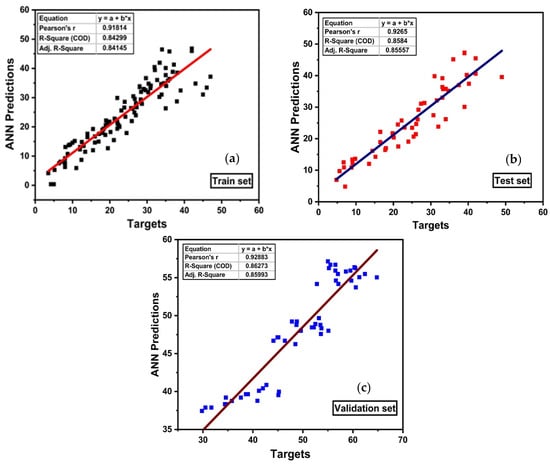
Figure 7.
Regression analysis of artificial-neural-network-based predictive model for (a) training, (b) testing, and (c) validation set data.

Table 8.
Details of statistical measures of the projected artificial neural network model.
The applicability of the developed ANN model was further evaluated by calculating the error distribution between the predicted and experimental values of training, testing, and validation datasets. Figure 8 shows the error distribution for the training, testing, and validation sets. The dark red shows the higher error values. The error value is low, which implies that the model accurately predicts the compressive strength of VAM.
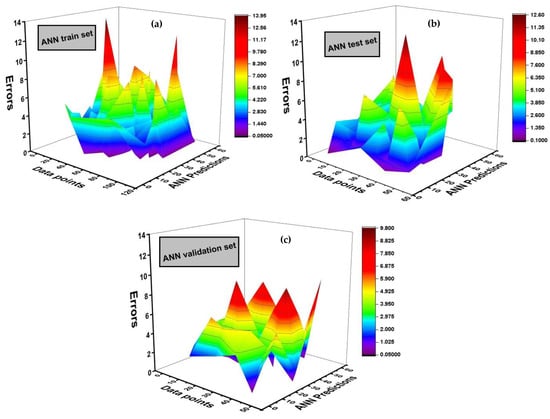
Figure 8.
Prediction accuracy in terms of error between actual and predicted results of artificial-neural-network-based model for (a) training, (b) testing, and (c) validation set data.
3.2.2. ANFIS Prediction Model
Table 9 presents the detailed statistical analysis and Figure 9 shows the regression analysis of training, testing, and validation set data of the ANFIS proposed model. The location of the points in the figures gives an idea to estimate the R-square. For the best model, the points will be nearer to the regression line. As shown in the figure, all the points in each stage are located nearer to the line. In all three stages, the R-square is greater than 0.9, i.e., 0.94, 0.95, and 0.96, for training, testing and validation sets. In addition, the error values are very low in comparison with the ANFIS predictive model. The MAE, RMSE, RRMSE, RSE, and ρ for the training set are 1.82, 2.51, 0.01, 0.058, and 0.05, respectively. Like ANN, for ANFIS the MAE values in each stage are lower than RMSE, depicting on the lower percentage of higher error values. Consequently, the RRMSEs for training, testing and validation sets are 0.01, 0.009, and 0.004, respectively, which are lower than 10% [85,86]. In addition, the performance index is nearer to 0, i.e., 0.05 and 0.2 for training/testing and validation sets, respectively. Comparatively, the ANFIS outperforms and gives an excellent prediction of the compressive strength of VAM.

Table 9.
Details of statistical measures of the projected adaptive-neuro-fuzzy-interface-system-based model.
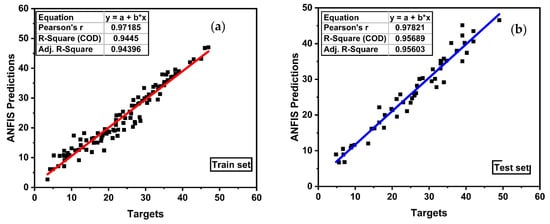
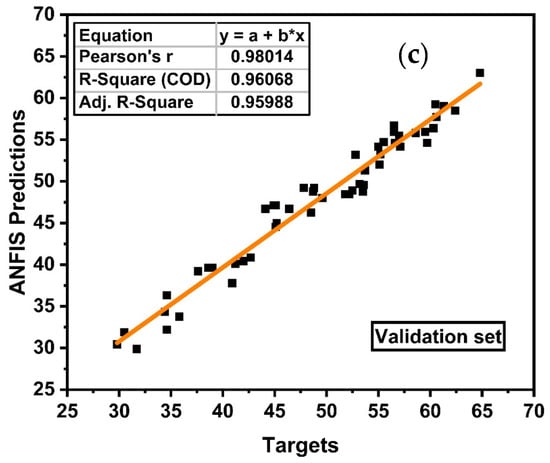
Figure 9.
Regression analysis of adaptive-neuro-fuzzy-interface-system-based predictive model for (a) training, (b) testing, and (c) validation set data.
For further assessment of the performance of the ANFIS predictive model, the predicted and error values of every data point are presented on the heat map in Figure 10, which shows the range of errors between experimental values and ANFIS predicted results in the form of different colors. The lower error values are less in each data set, which shows the accurateness of the ANFIS predictive model.
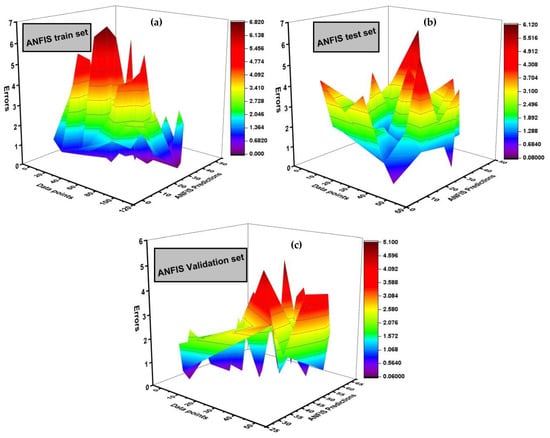
Figure 10.
Prediction accuracy in terms of error between actual and predicted results of adaptive-neuro-fuzzy-interface-system-based model for (a) training, (b) testing, and (c) validation set data.
3.2.3. Comparison between ANN and ANFIS Predictive Models
Each neural network (ANN and ANFIS) outperforms on the data provided for compressive strength results of VAM having four input variables. For comparing the performance of each predictive model, the targeted and predicted results along with the absolute error for every single data point are presented in Figure 11 and Figure 12. It can be seen that the absolute error of both prediction techniques runs near the x-axis, showing the accurate prediction of compressive strength of VAM. However, the maximum absolute errors for ANN and ANFIS models are 13.94 MPa and 6.89 MPa, respectively. The maximum error in ANFIS is below 10 MPa. The ANFIS predictions nearly follow their targeted values, giving an outburst estimation of the compressive strength of VAM. Based on RRMSE and performance index, the ANFIS model gives 41% and 50%, respectively, providing a better prediction than the ANN predictive model. The leading performance of ANFIS is attributable to its integrated algorithmic structure of ANN and a fuzzy logic technique.
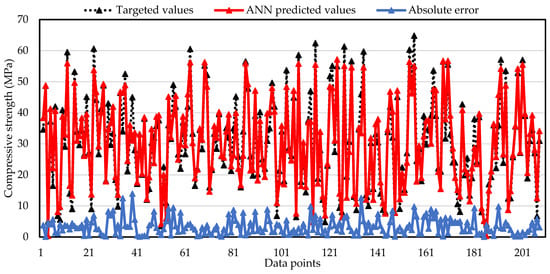
Figure 11.
Distribution of absolute error of artificial-neural-network-based predictive model.

Figure 12.
Distribution of absolute error of adaptive-neuro-fuzzy-interface-system-based predictive model.
3.2.4. Permutation Feature Analysis
There are several applications of neural networks in the field of engineering and research. Engineers employ ANN and ANFIS in developing new rules for optimizing different mechanical properties of concrete. However, these are often provided to clients in the form of a black box containing different nonlinear internal algorithms to estimate outputs based on the provided inputs. Due to this complexity of neural-network-based models, it is impossible to check the mechanisms involved just on the basis of network bias and weights for every problem [74]. Hence, it is difficult to convert ANN models in the form of simple equations connecting input variables with output. In addition, the effect of a single input parameter on the output cannot be calculated using traditional statistical methods.
To further verify the performance of the developed models, permutation feature analysis (PFA) was conducted to check the most influential input variable affecting the compressive strength of VAM [1,3,5]. For performing PFA, the extension from the Python programming software was used. As shown in Figure 13, the effect of each input on the compressive strength of VAM is prominent. The most important factor affecting the compressive strength of VAM is the age of curing (43.59%), followed by water-to-cement ratio (22.79%), curing temperature (17.87%), and volcanic ash percentage (15.75%).
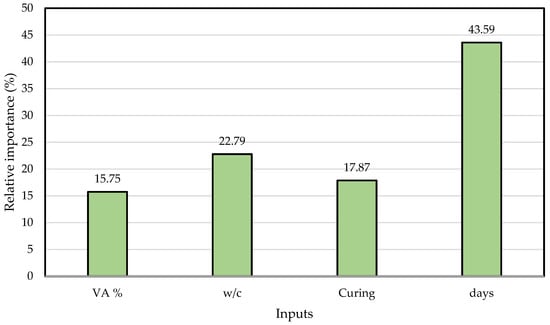
Figure 13.
Influence of all inputs (independent variables) on the compressive strength of volcanic ash mortar.
4. Conclusions
This study had a two-fold objective. First, we modeled the compressive strength of volcanic ash mortar (VAM) using an artificial neural network (ANN) and an adaptive neuro-fuzzy interface system (ANFIS). The models were proposed and formulated on the basis of detail and a high range data set developed from the literature. Second, VA was characterized, and used in varying proportions (i.e., 10%, 20%, and 30%) partially replacing the cement in mortar. VAM specimens were prepared, and their mechanical properties were tested. The results show that the use of different natural pozzolans as a substitute for cement is indispensable. Regarding the sustainability, machine learning models perform a central part in its achievement. Based on the results, analysis, and discussion in the preceding sections, the subsequent conclusions are presented.
- Compared to the standard curing temperature (20 °C), the compressive strength of VA-containing mortar improved significantly under high curing temperatures (40 °C and 60 °C). This is a good indication that such mortar could be applied under hot environmental conditions.
- Among all mortar mixes, the mortar containing a high percentage (30%) of ultra-fine volcanic ash (VUF30) exhibited the highest compressive strength at both 40 °C and 60 °C. This indicates that VA can be used in high percentages as a partial substitute for cement.
- ANN and ANFIS algorithms were exercised to estimate the compressive strength of the VAM. The accuracy, reliability, and performance of the final proposed models were assessed using statistical indicators, including RMSE, RSE, RRMSE, MAE, ρ, and R-square. The predicted results displayed an exceptional correlation with the experimental data with R2 value above 0.9 and RMSE and MAE below 5. Based on RRMSE and performance index, the ANFIS model gave 41% and 50%, respectively, providing a better prediction than the ANN predictive model.
- The permutation feature analysis (PFA) revealed that the developed model considers the effect of all the inputs. The most influential factor affecting the strength of VAM is the age of the specimen, followed by w/c, curing temperature, and VA%.
Author Contributions
M.N.A., K.K., F.I.S. and M.G.Q.: design and basic idea for research. K.K. and M.N.A.: experiment conduction and materials. M.F.J., M.N.A. and K.K.: modeling, analysis, and discussion of the results. F.I.S. and M.G.Q.: reviewing the initial draft. M.N.A.: editing and reviewing the final draft. All authors have read and agreed to the published version of the manuscript.
Funding
The authors acknowledge the Deanship of Scientific Research at King Faisal University, Al-Ahsa, Saudi Arabia, for the financial support under the Research Group Support Track (Grant No. 1811011).
Institutional Review Board Statement
Not applicable.
Informed Consent Statement
Not applicable.
Data Availability Statement
All the data utilized in current research are available on a reasonable request from the corresponding author.
Acknowledgments
The authors acknowledge the Deanship of Scientific Research at King Faisal University, Al-Ahsa, Saudi Arabia, for the financial support and “Super Burkani Blocks Company” for delivering the basaltic volcanic ash utilized in this study.
Conflicts of Interest
The authors declare no conflict of interest.
References
- Ali Khan, M.; Zafar, A.; Akbar, A.; Javed, M.F.; Mosavi, A. Application of Gene Expression Programming (GEP) for the Prediction of Compressive Strength of Geopolymer Concrete. Materials 2021, 14, 1106. [Google Scholar] [CrossRef] [PubMed]
- Khurram, N.; Khan, K.; Saleem, M.U.; Amin, M.N.; Akmal, U. Effect of Elevated Temperatures on Mortar with Naturally Occurring Volcanic Ash and Its Blend with Electric Arc Furnace Slag. Adv. Mater. Sci. Eng. 2018, 2018, 5324036. [Google Scholar] [CrossRef] [Green Version]
- Khan, M.A.; Memon, S.A.; Farooq, F.; Javed, M.F.; Aslam, F.; Alyousef, R. Compressive Strength of Fly-Ash-Based Geopolymer Concrete by Gene Expression Programming and Random Forest. Adv. Civ. Eng. 2021, 2021, 6618407. [Google Scholar]
- Javed, M.F.; Sulong, N.H.R.; Memon, S.A.; Rehman, S.K.-U.; Khan, N.B. Experimental and Numerical Study of Flexural Behavior of Novel Oil Palm Concrete Filled Steel Tube Exposed to Elevated Temperature. J. Clean. Prod. 2018, 205, 95–114. [Google Scholar] [CrossRef]
- Javed, M.F.; Amin, M.N.; Shah, M.I.; Khan, K.; Iftikhar, B.; Farooq, F.; Aslam, F.; Alyousef, R.; Alabduljabbar, H. Applications of Gene Expression Programming and Regression Techniques for Estimating Compressive Strength of Bagasse Ash Based Concrete. Crystals 2020, 10, 737. [Google Scholar] [CrossRef]
- Iqbal, M.F.; Liu, Q.-F.; Azim, I.; Zhu, X.; Yang, J.; Javed, M.F.; Rauf, M. Prediction of Mechanical Properties of Green Concrete Incorporating Waste Foundry Sand Based on Gene Expression Programming. J. Hazard. Mater. 2020, 384, 121322. [Google Scholar] [CrossRef]
- Rehman, S.K.U.; Ibrahim, Z.; Memon, S.A.; Javed, M.F.; Khushnood, R.A. A Sustainable Graphene Based Cement Composite. Sustainability 2017, 9, 1229. [Google Scholar] [CrossRef] [Green Version]
- Saharuddin, E.; Badaruzzaman, W.W.; Al Zand, A. Polymer-Based Composite Materials for Industralised Building System in Flooding Situations. In EASEC16; Springer: Berlin/Heidelberg, Germany, 2021; pp. 1053–1062. [Google Scholar]
- Javed, U.; Khushnood, R.A.; Memon, S.A.; Jalal, F.E.; Zafar, M.S. Sustainable Incorporation of Lime-Bentonite Clay Composite for Production of Ecofriendly Bricks. J. Clean. Prod. 2020, 263, 121469. [Google Scholar] [CrossRef]
- Memon, S.A.; Khan, S.; Wahid, I.; Shestakova, Y.; Ashraf, M. Evaluating the Effect of Calcination and Grinding of Corn Stalk Ash on Pozzolanic Potential for Sustainable Cement-Based Materials. Adv. Mater. Sci. Eng. 2020, 2020, 1619480. [Google Scholar] [CrossRef] [Green Version]
- Memon, S.A.; Shah, S.F.A.; Khushnood, R.A.; Baloch, W.L. Durability of Sustainable Concrete Subjected to Elevated Temperature-A Review. Constr. Build. Mater. 2019, 199, 435–455. [Google Scholar] [CrossRef]
- Ahmad, M.R.; Chen, B.; Shah, S.F.A. Mechanical and Microstructural Characterization of Bio-Concrete Prepared with Optimized Alternative Green Binders. Constr. Build. Mater. 2021, 281, 122533. [Google Scholar] [CrossRef]
- Shah, S.F.A.; Chen, B.; Ahmad, M.R.; Haque, M.A. Development of Cleaner One-Part Geopolymer from Lithium Slag. J. Clean. Prod. 2020, 291, 125241. [Google Scholar] [CrossRef]
- Imtiaz, L.; Rehman, S.K.U.; Ali Memon, S.; Khizar Khan, M.; Faisal Javed, M. A Review of Recent Developments and Advances in Eco-Friendly Geopolymer Concrete. Appl. Sci. 2020, 10, 7838. [Google Scholar] [CrossRef]
- Rahman, S.S.; Khattak, M.J. Feasibility of Roller Compacted Geopolymer Concrete Containing Recycle Concrete Aggregate. In Tran-SET 2020; American Society of Civil Engineers: Reston, VA, USA, 2021; pp. 305–313. [Google Scholar]
- Azad, A.; Saeedian, A.; Mousavi, S.-F.; Karami, H.; Farzin, S.; Singh, V.P. Effect of Zeolite and Pumice Powders on the Environmental and Physical Characteristics of Green Concrete Filters. Constr. Build. Mater. 2020, 240, 117931. [Google Scholar] [CrossRef]
- Nematzadeh, M.; Tayebi, M.; Samadvand, H. Prediction of Ultrasonic Pulse Velocity in Steel Fiber-Reinforced Concrete Containing Nylon Granule and Natural Zeolite after Exposure to Elevated Temperatures. Constr. Build. Mater. 2021, 273, 121958. [Google Scholar] [CrossRef]
- Masood, B.; Elahi, A.; Barbhuiya, S.; Ali, B. Mechanical and Durability Performance of Recycled Aggregate Concrete Incorporating Low Calcium Bentonite. Constr. Build. Mater. 2020, 237, 117760. [Google Scholar] [CrossRef]
- Ahmad, J.; Tufail, R.F.; Aslam, F.; Mosavi, A.; Alyousef, R.; Faisal Javed, M.; Zaid, O.; Khan Niazi, M.S. A Step towards Sustainable Self-Compacting Concrete by Using Partial Substitution of Wheat Straw Ash and Bentonite Clay Instead of Cement. Sustainability 2021, 13, 824. [Google Scholar] [CrossRef]
- Omrane, M.; Rabehi, M. Effect of Natural Pozzolan and Recycled Concrete Aggregates on Thermal and Physico-Mechanical Characteristics of Self-Compacting Concrete. Constr. Build. Mater. 2020, 247, 118576. [Google Scholar] [CrossRef]
- Haddad, R.H.; Lababneh, Z.K. Geopolymer Composites Using Natural Pozzolan and Oil-Shale Ash Base Materials: A Parametric Study. Constr. Build. Mater. 2020, 240, 117899. [Google Scholar] [CrossRef]
- Amin, M.N.; Hissan, S.; Shahzada, K.; Khan, K.; Bibi, T. Pozzolanic Reactivity and the Influence of Rice Husk Ash on Early-Age Autogenous Shrinkage of Concrete. Front. Mater. 2019, 6, 150. [Google Scholar] [CrossRef]
- Amin, M.N.; Murtaza, T.; Shahzada, K.; Khan, K.; Adil, M. Pozzolanic Potential and Mechanical Performance of Wheat Straw Ash Incorporated Sustainable Concrete. Sustainability 2019, 11, 519. [Google Scholar] [CrossRef] [Green Version]
- Belfiore, C.M.; Amato, C.; Pezzino, A.; Viccaro, M. An End of Waste Alternative for Volcanic Ash: A Resource in the Manufacture of Ceramic Tiles. Constr. Build. Mater. 2020, 263, 120118. [Google Scholar] [CrossRef]
- Xie, T.; Yang, G.; Zhao, X.; Xu, J.; Fang, C. A Unified Model for Predicting the Compressive Strength of Recycled Aggregate Concrete Containing Supplementary Cementitious Materials. J. Clean. Prod. 2020, 251, 119752. [Google Scholar] [CrossRef]
- Muthukrishnan, S.; Kua, H.W.; Yu, L.N.; Chung, J.K. Fresh Properties of Cementitious Materials Containing Rice Husk Ash for Construction 3D Printing. J. Mater. Civ. Eng. 2020, 32, 04020195. [Google Scholar] [CrossRef]
- Elahi, M.M.A.; Shearer, C.R.; Reza, A.N.R.; Saha, A.K.; Khan, M.N.N.; Hossain, M.M.; Sarker, P.K. Improving the Sulfate Attack Resistance of Concrete by Using Supplementary Cementitious Materials (SCMs): A Review. Constr. Build. Mater. 2021, 281, 122628. [Google Scholar] [CrossRef]
- Zhou, A.; Zhang, W.; Wei, H.; Liu, T.; Zou, D.; Guo, H. A Novel Approach for Recycling Engineering Sediment Waste as Sustainable Supplementary Cementitious Materials. Resour. Conserv. Recycl. 2021, 167, 105435. [Google Scholar] [CrossRef]
- Wang, H.; Hou, P.; Li, Q.; Adu-Amankwah, S.; Chen, H.; Xie, N.; Zhao, P.; Huang, Y.; Wang, S.; Cheng, X. Synergistic Effects of Supplementary Cementitious Materials in Limestone and Calcined Clay-Replaced Slag Cement. Constr. Build. Mater. 2021, 282, 122648. [Google Scholar] [CrossRef]
- Thomas, B.S.; Yang, J.; Mo, K.H.; Abdalla, J.A.; Hawileh, R.A.; Ariyachandra, E. Biomass Ashes from Agricultural Wastes as Supplementary Cementitious Materials or Aggregate Replacement in Cement/Geopolymer Concrete: A Comprehensive Review. J. Build. Eng. 2021, 40, 102332. [Google Scholar] [CrossRef]
- Habibi, A.; Ramezanianpour, A.M.; Mahdikhani, M. RSM-Based Optimized Mix Design of Recycled Aggregate Concrete Containing Supplementary Cementitious Materials Based on Waste Generation and Global Warming Potential. Resour. Conserv. Recycl. 2021, 167, 105420. [Google Scholar] [CrossRef]
- Sakir, S.; Raman, S.N.; Safiuddin, M.; Kaish, A.; Mutalib, A.A. Utilization of By-Products and Wastes as Supplementary Cementitious Materials in Structural Mortar for Sustainable Construction. Sustainability 2020, 12, 3888. [Google Scholar] [CrossRef]
- Liu, S.; Zhu, M.; Ding, X.; Ren, Z.; Zhao, S.; Zhao, M.; Dang, J. High-Durability Concrete with Supplementary Cementitious Admixtures Used in Corrosive Environments. Crystals 2021, 11, 196. [Google Scholar] [CrossRef]
- Shakouri, M.; Exstrom, C.L.; Ramanathan, S.; Suraneni, P. Hydration, Strength, and Durability of Cementitious Materials Incorporating Untreated Corn Cob Ash. Constr. Build. Mater. 2020, 243, 118171. [Google Scholar] [CrossRef]
- Ibrahim, M.; Johari, M.A.M.; Hussaini, S.R.; Rahman, M.K.; Maslehuddin, M. Influence of Pore Structure on the Properties of Green Concrete Derived from Natural Pozzolan and Nanosilica. J. Sustain. Cem.-Based Mater. 2020, 9, 233–257. [Google Scholar] [CrossRef]
- Ibrahim, M.; Rahman, M.K.; Johari, M.A.M.; Nasir, M.; Oladapo, E.A. Chloride Diffusion and Chloride-Induced Corrosion of Steel Embedded in Natural Pozzolan-Based Alkali Activated Concrete. Constr. Build. Mater. 2020, 262, 120669. [Google Scholar] [CrossRef]
- Amran, Y.M.; Soto, M.G.; Alyousef, R.; El-Zeadani, M.; Alabduljabbar, H.; Aune, V. Performance Investigation of High-Proportion Saudi-Fly-Ash-Based Concrete. Results Eng. 2020, 6, 100118. [Google Scholar] [CrossRef]
- Amin, M.N.; Khan, K. Mechanical Performance of High-Strength Sustainable Concrete under Fire Incorporating Locally Available Volcanic Ash in Central Harrat Rahat, Saudi Arabia. Materials 2021, 14, 21. [Google Scholar] [CrossRef]
- Siddique, R. Properties of Concrete Made with Volcanic Ash. Resour. Conserv. Recycl. 2012, 66, 40–44. [Google Scholar] [CrossRef]
- Siddique, R. Effect of volcanic ash on the properties of cement paste and mortar. Resour. Conserv. Recycl. 2011, 56, 66–70. [Google Scholar] [CrossRef]
- Hossain, K.; Lachemi, M. Fresh, Mechanical, and Durability Characteristics of Self-Consolidating Concrete Incorporating Volcanic Ash. J. Mater. Civ. Eng. 2010, 22, 651–657. [Google Scholar] [CrossRef]
- Khan, K.; Amin, M.N.; Saleem, M.U.; Qureshi, H.J.; Al-Faiad, M.A.; Qadir, M.G. Effect of Fineness of Basaltic Volcanic Ash on Pozzolanic Reactivity, ASR Expansion and Drying Shrinkage of Blended Cement Mortars. Materials 2019, 12, 2603. [Google Scholar] [CrossRef] [PubMed] [Green Version]
- Thorstensen, R.T.; Fidjestol, P. Inconsistencies in the Pozzolanic Strength Activity Index (SAI) for Silica Fume According to EN and ASTM. Mater. Struct. 2015, 48, 3979–3990. [Google Scholar] [CrossRef] [Green Version]
- Pekmezci, B.Y.; Akyüz, S. Optimum Usage of a Natural Pozzolan for the Maximum Compressive Strength of Concrete. Cem. Concr. Res. 2004, 34, 2175–2179. [Google Scholar] [CrossRef]
- Reuter, U.; Sultan, A.; Reischl, D.S. A Comparative Study of Machine Learning Approaches for Modeling Concrete Failure Surfaces. Adv. Eng. Softw. 2018, 116, 67–79. [Google Scholar] [CrossRef]
- Chaabene, W.B.; Flah, M.; Nehdi, M.L. Machine Learning Prediction of Mechanical Properties of Concrete: Critical Review. Constr. Build. Mater. 2020, 260, 119889. [Google Scholar] [CrossRef]
- Zhang, J.; Huang, Y.; Wang, Y.; Ma, G. Multi-Objective Optimization of Concrete Mixture Proportions Using Machine Learning and Metaheuristic Algorithms. Constr. Build. Mater. 2020, 253, 119208. [Google Scholar] [CrossRef]
- Okazaki, Y.; Okazaki, S.; Asamoto, S.; Chun, P.J. Applicability of Machine Learning to a Crack Model in Concrete Bridges. Comput. -Aided Civ. Infrastruct. Eng. 2020, 35, 775–792. [Google Scholar] [CrossRef]
- Han, T.; Siddique, A.; Khayat, K.; Huang, J.; Kumar, A. An Ensemble Machine Learning Approach for Prediction and Optimization of Modulus of Elasticity of Recycled Aggregate Concrete. Constr. Build. Mater. 2020, 244, 118271. [Google Scholar] [CrossRef]
- Cai, R.; Han, T.; Liao, W.; Huang, J.; Li, D.; Kumar, A.; Ma, H. Prediction of Surface Chloride Concentration of Marine Concrete Using Ensemble Machine Learning. Cem. Concr. Res. 2020, 136, 106164. [Google Scholar] [CrossRef]
- Nguyen, H.; Vu, T.; Vo, T.P.; Thai, H.-T. Efficient Machine Learning Models for Prediction of Concrete Strengths. Constr. Build. Mater. 2021, 266, 120950. [Google Scholar] [CrossRef]
- Olalusi, O.B.; Awoyera, P.O. Shear Capacity Prediction of Slender Reinforced Concrete Structures with Steel Fibers Using Machine Learning. Eng. Struct. 2021, 227, 111470. [Google Scholar] [CrossRef]
- Zhang, J.; Huang, Y.; Ma, G.; Nener, B. Mixture Optimization for Environmental, Economical and Mechanical Objectives In Silica Fume Concrete: A Novel Frame-Work Based on Machine Learning and a New Meta-Heuristic Algorithm. Resour. Conserv. Recycl. 2021, 167, 105395. [Google Scholar] [CrossRef]
- Cuong-Le, T.; Nghia-Nguyen, T.; Khatir, S.; Trong-Nguyen, P.; Mirjalili, S.; Nguyen, K.D. An Efficient Approach for Damage Identification Based on Improved Machine Learning Using PSO-SVM. Eng. Comput. 2021, 1–16. [Google Scholar] [CrossRef]
- Lin, S.-S.; Shen, S.-L.; Zhou, A.; Xu, Y.-S. Risk Assessment and Management of Excavation System Based on Fuzzy Set Theory and Machine Learning Methods. Autom. Constr. 2021, 122, 103490. [Google Scholar] [CrossRef]
- Marcelino, P.; de Lurdes Antunes, M.; Fortunato, E.; Gomes, M.C. Machine Learning Approach for Pavement Performance Prediction. Int. J. Pavement Eng. 2021, 22, 341–354. [Google Scholar] [CrossRef]
- Avci, O.; Abdeljaber, O.; Kiranyaz, S.; Hussein, M.; Gabbouj, M.; Inman, D.J. A Review of Vibration-Based Damage Detection in Civil Structures: From Traditional Methods to Machine Learning and Deep Learning Applications. Mech. Syst. Signal Process. 2021, 147, 107077. [Google Scholar] [CrossRef]
- Naser, M. Mechanistically Informed Machine Learning and Artificial Intelligence in Fire Engineering and Sciences. Fire Technol. 2021, 1–44. [Google Scholar] [CrossRef]
- Pham, B.T.; Nguyen, M.D.; Nguyen-Thoi, T.; Ho, L.S.; Koopialipoor, M.; Quoc, N.K.; Armaghani, D.J.; Van Le, H. A Novel Approach for Classification of Soils Based on Laboratory Tests Using Adaboost, Tree and ANN Modeling. Transp. Geotech. 2021, 27, 100508. [Google Scholar] [CrossRef]
- Abdullah, M.S.; Alaloul, W.S.; Liew, M.; Musarat, M.A. Delay and Cost Overrun of Palm Oil Refinery Construction Projects: Artificial Neural Network (ANN) Model. In Proceedings of the International Conference on Civil, Offshore and Environmental Engineering; Springer: Singapore, 2021; pp. 580–589. [Google Scholar]
- Liu, J.; Jiang, Y.; Han, W.; Sakaguchi, O. Optimized ANN Model for Predicting Rock Mass Quality ahead of Tunnel Face Using Measure-While-Drilling Data. Bull. Eng. Geol. Environ. 2021, 80, 2283–2305. [Google Scholar] [CrossRef]
- ASTM Committee C-09 on Concrete and Concrete Aggregates. Standard Specification for Coal Fly Ash and Raw or Calcined Natural Pozzolan for Use as a Mineral Admixture in Concrete; ASTM International: West Conshohocken, PA, USA, 2019. [Google Scholar]
- ASTM Committee C-09 on Concrete and Concrete Aggregates. Standard Practice for Making and Curing Concrete Test Specimens in the Laboratory; ASTM International: West Conshohocken, PA, USA, 2016. [Google Scholar]
- Khan, K.; Amin, M.N. Influence of Fineness of Volcanic Ash and Its Blends with Quarry Dust and Slag on Compressive Strength of Mortar under Different Curing Temperatures. Constr. Build. Mater. 2017, 154, 514–528. [Google Scholar] [CrossRef]
- Azim, I.; Yang, J.; Iqbal, M.F.; Mahmood, Z.; Javed, M.F.; Wang, F.; Liu, Q.-f. Prediction of Catenary Action Capacity of RC Beam-Column Substructures under a Missing Column Scenario Using Evolutionary Algorithm. KSCE J. Civ. Eng. 2021, 25, 891–905. [Google Scholar] [CrossRef]
- Shah, M.I.; Javed, M.F.; Abunama, T. Proposed Formulation of Surface Water Quality and Modelling Using Gene Expression, Machine Learning, and Regression Techniques. Environ. Sci. Pollut. Res. 2020, 28, 13202–13220. [Google Scholar] [CrossRef] [PubMed]
- Dao, D.V.; Ly, H.-B.; Vu, H.-L.T.; Le, T.-T.; Pham, B.T. Investigation and Optimization of the C-ANN Structure in Predicting the Compressive Strength of Foamed Concrete. Materials 2020, 13, 1072. [Google Scholar] [CrossRef] [PubMed] [Green Version]
- Kumar, S.; Roshni, T.; Himayoun, D. A Comparison of Emotional Neural Network (ENN) and Artificial Neural Network (ANN) Approach for Rainfall-Runoff Modelling. Civ. Eng. J. 2019, 5, 2120–2130. [Google Scholar] [CrossRef]
- Chakraborty, A.; Goswami, D. Prediction of Slope Stability Using Multiple Linear Regression (MLR) and Artificial Neural Network (ANN). Arab. J. Geosci. 2017, 10, 385. [Google Scholar] [CrossRef]
- McCulloch, W.S.; Pitts, W. A Logical Calculus of the Ideas Immanent in Nervous Activity. Bull. Math. Biophys. 1943, 5, 115–133. [Google Scholar] [CrossRef]
- Moayedi, H.; Mehrabi, M.; Mosallanezhad, M.; Rashid, A.S.A.; Pradhan, B. Modification of Landslide Susceptibility Mapping Using Optimized PSO-ANN Technique. Eng. Comput. 2019, 35, 967–984. [Google Scholar] [CrossRef]
- Zadeh, L.A. Fuzzy Sets, in Fuzzy Sets, Fuzzy Logic, and fuzzy Systems: Selected Papers by Lotfi a Zadeh; World Scientific Publishing: Singapore, 1996; pp. 394–432. [Google Scholar]
- Khan, M.A.; Zafar, A.; Farooq, F.; Faisal Javed, M.; Alyousef, R.; Alabduljabbar, H.; Khan, M.I. Geopolymer Concrete Compressive Strength via Artificial Neural Network, Adaptive Neuro Fuzzy Interface System, and Gene Expression Programming with K-Fold Cross Validation. Front. Mater. 2021, 8, 621163. [Google Scholar] [CrossRef]
- Jalal, F.E.; Xu, Y.; Iqbal, M.; Faisal Javed, M.; Jamhiri, B. Predictive Modeling of Swell-Strength of Expansive Soils Using Artificial Intelligence Approaches: ANN, ANFIS and GEP. J. Environ. Manag. 2021, 289, 112420. [Google Scholar] [CrossRef] [PubMed]
- Shannag, M.J.; Yeginobali, A. Properties of Pastes, Mortars and Concretes Containing Natural Pozzolan. Cem. Concr. Res. 1995, 25, 647–657. [Google Scholar] [CrossRef]
- Hossain, K.M.A. Blended Cement Using Volcanic Ash and Pumice. Cem. Concr. Res. 2003, 33, 1601–1605. [Google Scholar] [CrossRef]
- Ezziane, K.; Bougara, A.; Kadri, A.; Khelafi, H.; Kadri, E. Compressive Strength of Mortar Containing Natural Pozzolan under Various Curing Temperature. Cem. Concr. Compos. 2007, 29, 587–593. [Google Scholar] [CrossRef]
- Ezziane, K.; Kadri, E.-H.; Bougara, A.; Bennacer, R. Analysis of Mortar Long-Term Strength with Supplementary Cementitious Materials Cured at Different Temperatures. ACI Mater. J. 2010, 107, 323–331. [Google Scholar]
- Letelier, V.; Ortega, J.M.; Tremiño, R.M.; Henriquéz-Jara, B.I.; Fustos, I.; Real-Herraiz, T.; Moriconi, G.; Climent, M.Á.; Sánchez, I. The Use of Volcanic Powder as a Cement Replacement for the Development of Sustainable Mortars. Appl. Sci. 2020, 10, 1460. [Google Scholar] [CrossRef] [Green Version]
- Celik, K.; Hay, R.; Hargis, C.W.; Moon, J. Effect of Volcanic Ash Pozzolan or Limestone Replacement on Hydration of Portland Cement. Constr. Build. Mater. 2019, 197, 803–812. [Google Scholar] [CrossRef]
- Fares, G.; Alhozaimy, A.; Alawad, O.A.; Al-Negheimish, A. Evaluation of Powdered Scoria Rocks from Various Volcanic Lava Fields as Cementitious Material. J. Mater. Civ. Eng. 2016, 28, 04015139. [Google Scholar] [CrossRef]
- Mohamad, S.A.; Al-Hamd, R.K.S.; Khaled, T.T. Investigating the Effect of Elevated Temperatures on the Properties of Mortar Produced with Volcanic Ash. Innov. Infrastruct. Solut. 2020, 5, 25. [Google Scholar] [CrossRef]
- Al-Fadala, S.; Chakkamalayath, J.; Al-Bahar, S.; Al-Aibani, A.; Ahmed, S. Significance of Performance Based Specifications in the Qualification and Characterization of Blended Cement Using Volcanic Ash. Constr. Build. Mater. 2017, 144, 532–540. [Google Scholar] [CrossRef]
- Siddique, R.; Singh, G. Utilization of Waste Foundry Sand (WFS) in Concrete Manufacturing. Resour. Conserv. Recycl. 2011, 55, 885–892. [Google Scholar] [CrossRef]
- Iqbal, M.F.; Faisal Javed, M.; Rauf, M.; Azim, I.; Ashraf, M.; Yang, J.; Liu, Q.-F. Sustainable Utilization of Foundry Waste: Forecasting Mechanical Properties of Foundry Sand Based Concrete Using Multi-Expression Programming. Sci. Total. Environ. 2021, 780, 146524. [Google Scholar] [CrossRef]
- Chu, H.-H.; Ali Khan, M.; Javed, M.; Zafar, A.; Khan, M.I.; Alabduljabbar, H.; Qayyum, S. Sustainable Use of Fly-Ash: Use of Gene-Expression Programming (GEP) and Multi-Expression Programming (MEP) for Forecasting the Compressive Strength Geopolymer Concrete. Ain Shams Eng. J. 2021, in press. [Google Scholar] [CrossRef]
Publisher’s Note: MDPI stays neutral with regard to jurisdictional claims in published maps and institutional affiliations. |
© 2021 by the authors. Licensee MDPI, Basel, Switzerland. This article is an open access article distributed under the terms and conditions of the Creative Commons Attribution (CC BY) license (https://creativecommons.org/licenses/by/4.0/).